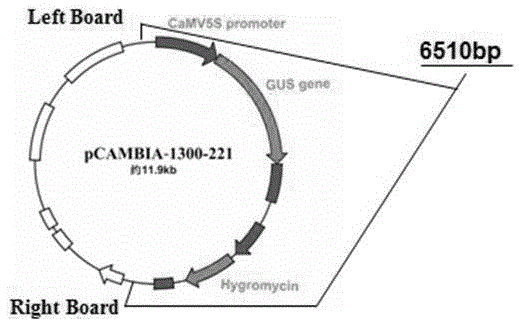Application of cell-penetrating peptide TAT2 in transgenic cotton cultivation
A technology of TAT2 and membrane-penetrating peptide, which is applied in the field of genetic engineering to achieve the effects of low production cost, improved genetic transformation efficiency, and easy operation
- Summary
- Abstract
- Description
- Claims
- Application Information
AI Technical Summary
Problems solved by technology
Method used
Image
Examples
Embodiment 1
[0040] This example mainly introduces the preparation process of the DNA fragments to be transformed as follows, which mainly involves the extraction of a large number of plasmids (plasmid DNA) and the amplification of linear DNA. The pCAMBIA1300-221 plasmid adopted in the present invention has GUS gene and hygromycin resistance gene, and its structure is as follows figure 1 As shown, the 6510bp part shown in the figure is the linear DNA part.
[0041]According to the conventional genetic engineering operation method, the functional exogenous gene is amplified by PCR, connected with the pCAMBIA1300-221 plasmid or linear DNA, then transformed into Escherichia coli, screened positive strains, amplified and cultured, and finally extracted the plasmid DNA in the positive strains Or linear DNA will do.
[0042] Plasmid extraction (i.e. plasmid DNA, linear DNA, plasmid DNA carrying exogenous DNA fragments or linear DNA carrying exogenous DNA fragments) can be performed using the en...
Embodiment 2
[0060] Using the DNA to be transformed prepared in Example 1 (in order to ensure the versatility of this method, only plasmid DNA and linear DNA were used for verification, and plasmid DNA or linear DNA carrying foreign DNA fragments were not used) to penetrate the membrane When the peptide TAT2 mediates the cultivation of new transgenic cotton, the relevant experimental steps are as follows.
[0061] (1) Preparation of transformation solution
[0062] It is composed of the membrane-penetrating peptide TAT2 and the DNA to be transformed. In terms of mass ratio, the membrane-penetrating peptide TAT2:the DNA to be transformed=1:1;
[0063] In this example, the concentration of DNA is 30 μg / mL, and the concentration of penetrating peptide TAT2 is 30 μg / mL;
[0064] The DNA to be transformed is the plasmid DNA and linear DNA prepared in Example 1.
[0065] (2) After the cotton is fertilized, the transformation solution is injected
[0066] After the cotton has bloomed and ferti...
PUM
 Login to View More
Login to View More Abstract
Description
Claims
Application Information
 Login to View More
Login to View More - R&D
- Intellectual Property
- Life Sciences
- Materials
- Tech Scout
- Unparalleled Data Quality
- Higher Quality Content
- 60% Fewer Hallucinations
Browse by: Latest US Patents, China's latest patents, Technical Efficacy Thesaurus, Application Domain, Technology Topic, Popular Technical Reports.
© 2025 PatSnap. All rights reserved.Legal|Privacy policy|Modern Slavery Act Transparency Statement|Sitemap|About US| Contact US: help@patsnap.com



